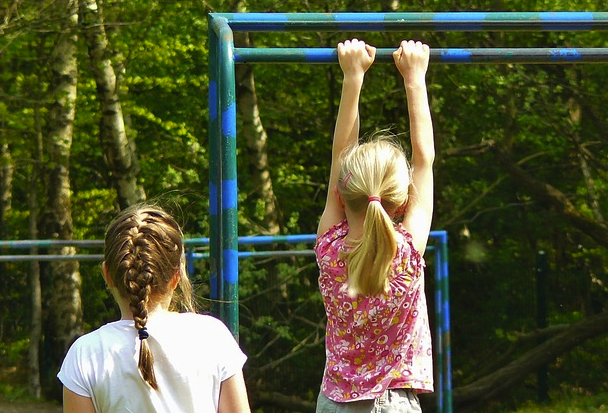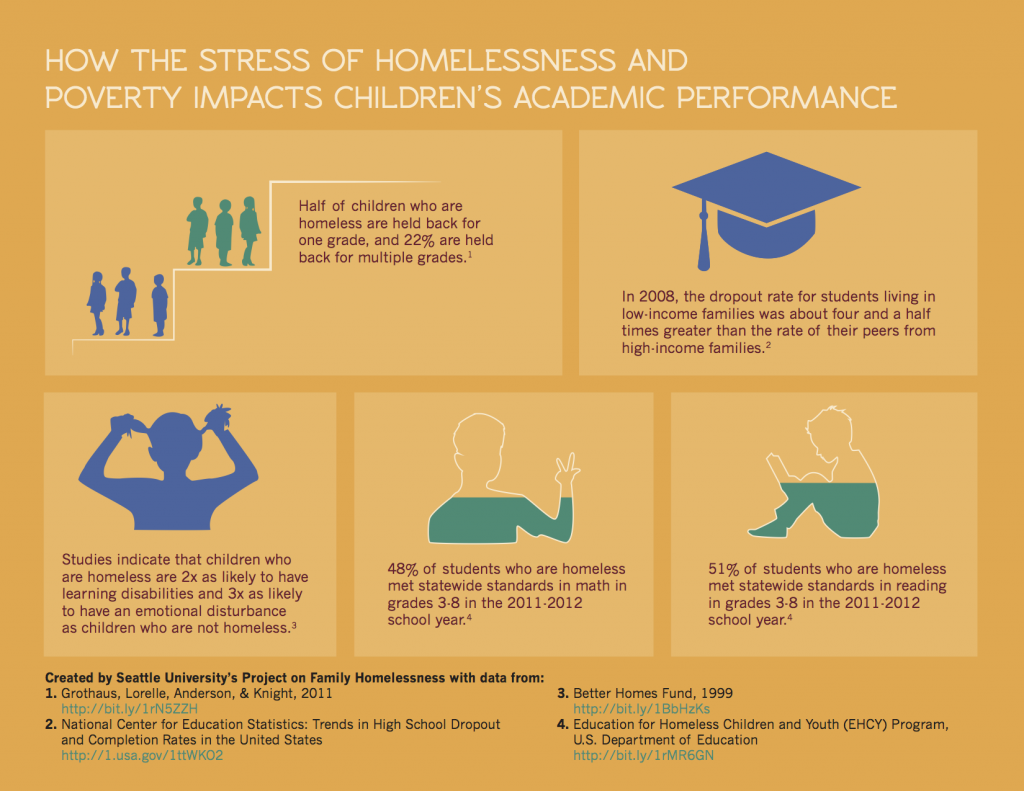Part Three in our series on homelessness and poverty in the public education system
Written by Perry Firth, project coordinator, Seattle University’s Project on Family Homelessness and school psychology graduate student
Students who are homeless face a variety of difficult challenges, not the least of which is finding a calm, quiet place to do homework. However, as we discussed in Part 2 of this series, it isn’t always the physical obstacles presented by poverty and homelessness that can be the most destructive.
Sometimes, the biggest obstacle to academic success can be the effects of toxic stress — the potentially lasting impact of the deprivation that can accompany poverty and homelessness.
The academic and cognitive consequences of homelessness for younger children
Research done on maltreated children has found that they have smaller vocabularies and are less able to form age–appropriate sentences than their peers.
However, it is not only maltreated children who have problems with vocabulary and sentence formation; children experiencing homelessness do as well. This occurs for a variety of reasons, including that they may hear fewer words, and are less likely to be raised in an environment that is rich in educational materials. Further, the language they do hear is more likely to be “concrete” and literal, as opposed to abstract and adjective rich. And of course, this limits their language development.
However, as we know from the research presented earlier in this series, toxic stress also hurts learning and memory. Therefore, children’s developing language skills are not immune from how their bodies and brains are processing the stress around them.
Researchers studying homelessness have found that of the homeless preschoolers they tested, more than half had vocabularies at or below the first percentile. This means that they recognized fewer words than 99 percent of the other preschoolers.
These same researchers also found that:
- One third of the preschoolers experiencing homelessness had motor-visual abilities that placed them at the fifth percentile.
- And more than a third (38 percent) had emotional-behavioral problems.
Relatedly, of children who are homeless under age five, more than 75 percent have at least one major delay, most commonly in impulsivity or speech.

Developmental delays are harmful not only because they cause children to fall behind, but because they slow a child’s ability to progress to new stages of learning and development.
So by the time pre-schoolers who have experienced homelessness hit middle childhood and the rigor of elementary school, the consequences of poverty reveal themselves in myriad ways.
Academic consequences of homelessness for older children
Given the numerous obstacles in their lives, it should come as no surprise that children who are homeless fare poorly on standardized testing.
- Only 51 percent of kids who are homeless met statewide standards in reading in grades 3-8 nationally in the 2011-2012 school year. Relatedly, most students who are homeless can’t spell or read on grade level.
- Only 48 percent of students who are homeless met statewide standards in math that same year.

Powerfully illustrating the impact of poverty on achievement, these test scores only hint at a larger problem of academic skill deficiencies and stress-induced cognitive changes.
As we’ve discussed in an earlier post, children who are homeless:
- Have twice the rate of learning disabilities;
- Are four times more likely to show a developmental delay than middle-income children;
- Have three times the rate of emotional-behavioral disorders than children who are housed.
What’s more, half of school–age children who are homeless experience anxiety, depression and withdrawal. Compare this to only 18 percent of stably housed children, who simply do not experience the same level of emotional turmoil.
Finally, the interaction between toxic stress and the many other barriers presented by homelessness and poverty results in children failing to progress through grade levels.
- Fully half of homeless children are held back for one grade;
- 22 percent are retained for multiple grades.
Poverty alone can reduce academic success
A child doesn’t need to be homeless to experience these academic consequences. Poverty alone is enough to reduce IQ and educational attainment, and increase school drop out.
Further, as we’ve observed throughout this series, it’s not only poverty and toxic stress which are harmful to children, but their timing. Therefore, interesting relationships emerge between poverty and when it occurs during child development.
For instance,
- Poverty during early childhood is more strongly associated with how far a child progresses in school than poverty that comes later in life.
- We can see a “dose-response”’ pattern emerge, where child outcomes are related to the extent to which they’ve been exposed to impoverished conditions over time.
Intellectual ability may follow this pattern.
As measured by IQ score, intellectual ability varies with the intensity of poverty that a child has been exposed to, according to the Journal of Pediatrics. On average, IQ scores in children living in poverty are 6 to 13 points lower than children who are not.

Caring adults can help overcome barriers
Children who are homeless and in poverty face many barriers to school success. From reduced access to healthy food, to chaotic environments at home, to no home at all, their developing systems carry the invisible imprint of early and sustained stress.
Ultimately, this shows up in the educational system in:
- reduced achievement on state tests,
- disproportionately high rates of developmental delays and learning disabilities, and
- high rates of grade retention (being held back).
These are all major obstacles; yet with adult action they are not insurmountable. Just as these children do the best they can with what they have to work with, so too do many committed staff in the public education system.
Summary
- Children who are homeless or in poverty are more likely than their peers to have developmental delays, learning disabilities and reduced academic achievement.
- Developmental delays are harmful because they slow a child’s ability to move onto more advanced stages of skill development.
- Chronic toxic stress and environmental deprivation are some of the reasons that children raised in chronic poverty show academic skill deficiencies.
In Part Four, the next post in this series, we’ll present an overview of the unique obstacles these school staff face as they provide a range of services to youth experiencing homelessness.
What you can do
- Read my colleague Krista Kent’s first-hand account of the many caring volunteers filling 1,300 backpacks with needed back-to-school supplies for children, in the blog post Project Cool: Supplying a Brighter Future for Children who are Homeless.
- Watch this Firesteel video in which Washington state educators explain why they advocated in Olympia this year to help homeless students.
- Interested in the importance of early intervention for children who have developmental delays, academic skill deficiencies and learning disorders? Spend some time exploring King County’s Early Intervention Services website.
Read other posts in this series
- Part One | Hungry, Scared, Tired and Sick: How Homelessness Hurts Children
- Part Two | Homelessness, Poverty and the Brain: Mapping the Effects of Toxic Stress on Children
- Part Four | More Barriers to Learning: Homelessness and the Special Education System
- Part Five | A Web of Risk: Homelessness and the Special Education Category “Emotional Disturbance”
- Part Six | McKinney-Vento, IDEA and You: Strategies for Helping Homeless Children With Disabilities
- Part Seven | Innovating Toward Academic Success: Empowering Students Who Are Homeless or Living With Toxic Stress
![Describing how she gets her homework done even though her family’s power was cut off, a young girl profiled on 60 Minutes’ “<a href="http://www.cbsnews.com/news/homeless-children-the-hard-times-generation-20-06-2011/4/">Homeless Children: The Hard Times Generation</a>” says, “[I] just light candles and sit around in a circle of candles.” Image from pixabay.com](http://firesteelwa.org/wpsystem/wp-content/uploads/2014/09/Firesteel-Classroom-Series-Part-Three_Candles_pixabay.png)
Pingback: New Infographics on Childhood Homelessness, Education, and Child Development | Seattle University Project on Family Homelessness()
Pingback: Out in the Cold: Homelessness & Academic Performance | Community One Blog()
Pingback: Homeless to Renter (H2R): A model of congregational initiative and collaboration | Faith & Family Homelessness Project()